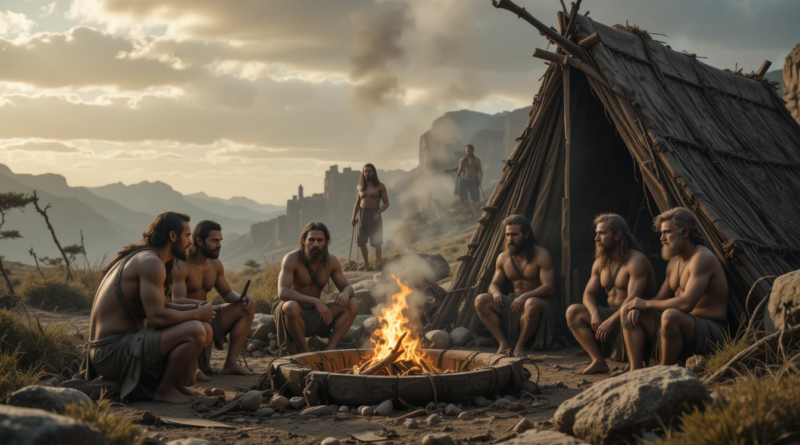How Humanity Nearly Vanished 900,000 Years Ago
New genetic evidence reveals humanity’s most harrowing chapter—when our entire species teetered on the knife’s edge of extinction
Nearly a million years ago, our ancestors faced their darkest hour—a catastrophic population crash that left fewer than 1,300 breeding individuals clinging to survival for over 100,000 years. This wasn’t merely a difficult period; it was humanity’s closest brush with complete extinction.
The Discovery That Rewrote Our Origins
In 2023, a groundbreaking study published in Science by Dr Yi-Hsuan Pan and colleagues at East China Normal University shattered conventional understanding of human evolution. Using sophisticated genomic analysis of present-day humans, the research team uncovered a severe population bottleneck with about 1,280 breeding individuals between around 930,000 and 813,000 years ago. This represented a staggering 98.7% reduction in population—a figure that would make modern conservation biologists declare any species critically endangered.
The implications are profound. The bottleneck lasted for about 117,000 years and brought human ancestors close to extinction—a timespan that dwarfs recorded human history. To put this in perspective, these survivors endured more than twice as long as modern humans have existed as a distinct species.
The Perfect Storm of Catastrophe
What could have driven humanity to such desperate straits? The Early to Middle Pleistocene transition, roughly 900,000 years ago, marked one of Earth’s most tumultuous periods. Temperatures changed, severe droughts persisted, and food sources may have dwindled as animals like mammoths, mastodons, and giant sloths went extinct.
This wasn’t a single catastrophic event but rather a convergence of environmental disasters. Massive glaciation cycles locked up vast amounts of water, altering landscapes and weather patterns across continents. Volcanic activity spewed ash into the atmosphere, blocking sunlight and disrupting global temperatures. Prolonged droughts turned once-fertile regions into barren wastelands.
The fossil record from this period tells a story of widespread species extinction and environmental upheaval. Our ancestors, still relatively new to the evolutionary stage, found themselves trapped in shrinking habitable zones, competing for dwindling resources in an increasingly hostile world.
The Genetic Fingerprint of Survival
The scars of this ancient bottleneck run deep in our DNA. An estimated 65.85 percent of current genetic diversity may have been lost due to this bottleneck—a genetic legacy that still influences human populations today. This dramatic reduction in genetic variation explains why humans, despite our global spread, show remarkably little genetic diversity compared to other species.
The bottleneck may have coincided with—or even triggered—one of the most significant genetic events in human evolution. Some researchers propose that the fusion of two ancestral chromosomes to form what we now call chromosome 2 occurred during this period. This chromosomal merger represents one of the key genetic differences between humans and our closest relatives, the great apes.
The Survivors’ Sanctuaries
Where did these precious few survivors weather the storm? Archaeological evidence suggests they likely found refuge in isolated pockets of suitable habitat—perhaps caves, river valleys, or coastal areas that remained relatively stable during the climatic chaos. The human population may have lingered at about 1,300 for more than 100,000 years, and that population bottleneck could have fueled the divergence between modern humans, Neanderthals and Denisovans.
These scattered groups, cut off from one another by vast expanses of inhospitable terrain, began to follow separate evolutionary paths. The isolation and genetic drift that occurred during this period may have set the stage for the eventual emergence of distinct hominin lineages.
The Long Road to Recovery
As the climate gradually stabilised and our ancestors developed crucial survival technologies—particularly the controlled use of fire—population numbers began their slow recovery. The mastery of fire was revolutionary, providing warmth, protection from predators, the ability to cook food, and extended daylight hours. These innovations allowed small groups to survive in previously uninhabitable regions and gradually expand their territories.
The recovery wasn’t swift. It took tens of thousands of years for human populations to rebound substantially. During this gradual resurgence, our ancestors developed increasingly sophisticated tools, social structures, and survival strategies that would eventually enable them to spread across the globe.
Implications for Modern Humanity
This ancient bottleneck offers sobering lessons for our modern world. Senior author and anthropologist Giorgio Manzi of Sapienza University of Rome sheds light on the bigger picture, noting that the research reveals how vulnerable human populations can be to environmental pressures, even when spread across multiple continents.
The study demonstrates that humans have faced extinction-level events before and survived through a combination of adaptability, cooperation, and sheer luck. However, it also highlights how dramatically such events can reshape our species’ genetic makeup and evolutionary trajectory.
The Enduring Mystery
Despite these remarkable insights, significant questions remain. Why did our ancestors survive when so many other species perished? What specific adaptations or behaviours gave them the edge? How did such small, isolated populations maintain sufficient genetic diversity to avoid inbreeding depression?
Recent research continues to refine our understanding of this pivotal period. Some studies suggest the bottleneck may have been even more severe in certain regions, while others propose that small populations may have persisted in refugia that haven’t yet been identified in the archaeological record.
A Testament to Resilience
The story of humanity’s near-extinction is ultimately one of extraordinary resilience. From fewer than 1,300 individuals scattered across a hostile world, our species not only survived but eventually thrived. We became explorers, artists, scientists, and builders of civilisations. We developed languages, cultures, and technologies that would have been unimaginable to those desperate survivors huddled around fires in the Pleistocene darkness.
This research fundamentally reshapes our understanding of human origins. Rather than a steady ascent from primitive beginnings, our evolutionary journey was marked by dramatic setbacks and remarkable recoveries. The fact that every human alive today descends from those few thousand survivors makes their story our story—a testament to the tenacity and adaptability that define our species.
As we face our own environmental challenges in the 21st century, the tale of our ancestors’ survival offers both warning and hope. It reminds us that even the most severe bottlenecks can be overcome, but only through the combination of ingenuity, cooperation, and the preservation of our planet’s life-supporting systems.
The next time you look around at the bustling diversity of human civilisation, remember that it all traces back to those remarkable few who refused to surrender in humanity’s darkest hour. Their survival is our inheritance, and their resilience flows through every generation that followed.
We’d love your questions or comments on today’s topic!
For more articles like this one, click here.
Thought for the day:
“I have always been delighted at the prospect of a new day, a fresh try, one more start, with perhaps a bit of magic waiting somewhere behind the morning.” J. B. Priestley



